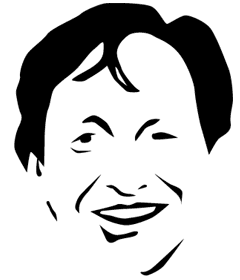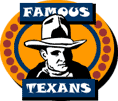


|



Rauschenberg's has been a full life: Christian fundamentalist upbringing, breakaway study in Paris and the Art Students League, fame, money, more fame, more money, an island home off Florida, bouts of drinking, bouts of quitting, commendable public works (among other things, his foundation provides funds for needy artists). Along with longtime friends pre-Pop painter Jasper Johns and the late conceptual composer John Cage, Rauschenberg pretty much defined the technical and philosophic art landscape and its offshoots after Abstract Expressionism.
Born in Texas in 1925 at Port Arthur, Texas, Rauschenberg wanted to be a minister but gave it up because the church prohibited dancing and he loved to dance.
In 1942 he studied pharmacy briefly at the University of Texas, following which he was drafted into the U.S. Marines. From 1947 to 1948 he studied at famous schools like the Kansas City Art Institute and Black Mountain College near Asheville, N.C., including various subjects such as art history, sculpture and music. During this time he did window displays, executed film sets and designed photographic studios. In 1948 he attended the Académie Julian, Paris, met Susan Weil, who was later to become his wife, and returned to the USA to study under Joseph Albers at the Black Mountain College, North Carolina. Exiled European Josef Albers put the green artist through his paces. (This may be what gives the work such formal rigor.)
At Black Mountain College Rauschenberg met the choreographer Merce Cunningham and the composer John Cage in 1949 and collaborated closely with both of them. In the same year he moved to New York and studied at the Art Students' League until 1952. He did window displays for Bonwit Teller and Tiffany, had his first one-man exhibitions in 1951 and returned to Black Mountain College in 1952. He
traveled in Italy, France and Spain and had exhibition in 1953 at Florence and Rome. He moved into a studio in New York in the same year and started to paint his red pictures, replacing the all-white and all-black paintings. Earliest works were white and black fields influenced by and influencing Cage. Already an art guru, in the '50s Cage staged a performance of three minutes of complete silence, setting in motion the
anti-art strategies found in Rauschenberg and in much work today.
By the mid-'50s, Rauschenberg was making the wild assemblage and collaged multimedia works for which he is best known. Called "combines" by Rauschenberg (maybe to denote the combination of two- and three-dimensional space, of art and life, of many media), these works covered found objects like a bed or a stuffed chicken with befuddingly beautiful passages of paint. Between 1954 and 1965 he intensified his work for the Merce Cunningham Dance Company. In 1955 he moved into a studio in the same neighborhood as Jasper Johns. In 1958 he had his first exhibition at the Leo Castelli gallery and began his drawings to illustrate Dante's "Inferno". In 1959 he was represented at the documenta "2", Kassel, and at the Paris and São Paulo Biennales. In 1960 he met Marcel Duchamp. In 1962 he first used the technique of silkscreen on canvas, mixed with painting, collage and affixed objects. He also did his first
lithographic work, for which he was awarded the Grand Prix at Ljubljana. In 1963 he was given his first retrospective exhibition in Europe at the Galerie Sonnabend, Paris, also shown at the Jewish Museum, New York. He produced his first dance performance Pelican. In 1964 he had a retrospective at the Whitechapel Gallery, London, and won the Grand Prix at the Venice Biennale. He went on world tour with Cage and Cunningham's Dance Company. In 1967 he made his Revolvers - with revolving
Plexiglas discs. That year (the same year as Martin Luther King) he was made honorary doctor of Grinnel College, Iowa. In 1968 he was invited by NASA to witness the lift-off of Apollo 11 at Kennedy Space Center and to use this theme in his work. He set up the foundation Change Inc. for destitute artists in 1970, and a house with art studios in Florida in 1971.
By the '70s, Rauschenberg began his now-signature procedure of building visual fields from collisions of appropriated media images: snippets from Esquire, Newsweek, popular dailies, trashy pulp silk-screened and hand-altered to blend and battle on fabric, canvas, metal, glass, you name it. Again and again, works fused classical nudes, girlie mags, satellites, rocketry, weaponry, abandoned bikes, faces of famous politicos, non-Western artifacts, tossed together in exactly the helter-skelter way we are forced to process experience in an information age.
In 1974 he collaborated with the writer Alain Robbe-Grillet. He also travelled to Israel and India. In 1975 he received the Honorary Degree of Fine Arts from the University of South Florida, Tampa, and, together with James Rosenquist, became involved in appealing for a re-examination of taxation for non-profitmaking art institutions. A large retrospective of his work was shown in several American cities from 1976-78. In 1980 he had retrospectives at Berlin, Düsseldorf, Copenhagen, Frankfurt, Munich and London. In 1981 his photographs were shown at the Centre Pompidou, Paris. He lives in New York City and on Captiva Island, Florida.
Throughout his career, Rauschenberg has told writers and viewers not to read messages into a work that is about process and materials. But it is hard not to read some charred angst in the black canvases, to see the frenzy of the city in the collaged junk, and to see existential edge, even a sense of loss, in his work.
Bibliography:
"Rauschenberg's Signature on the Century", Marlena Donohue, Special to "The Christian Science Monitor"